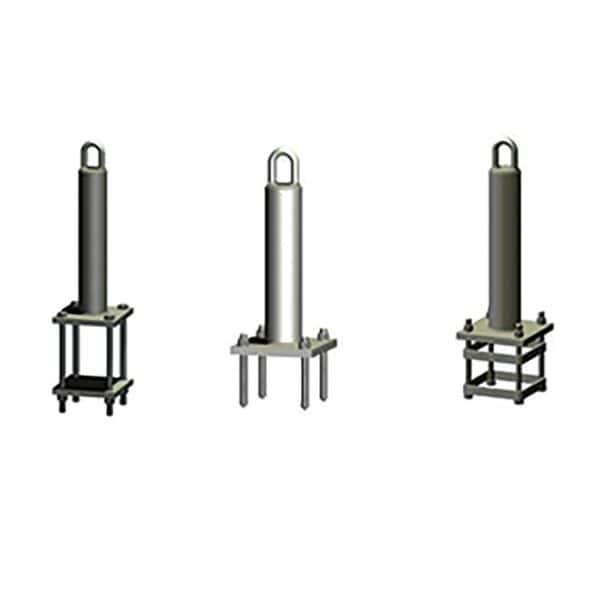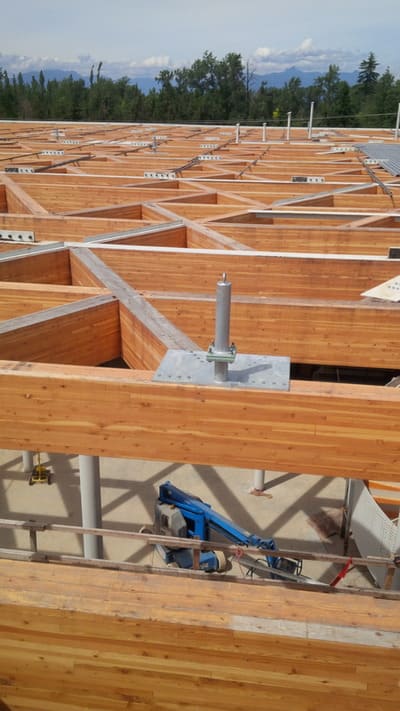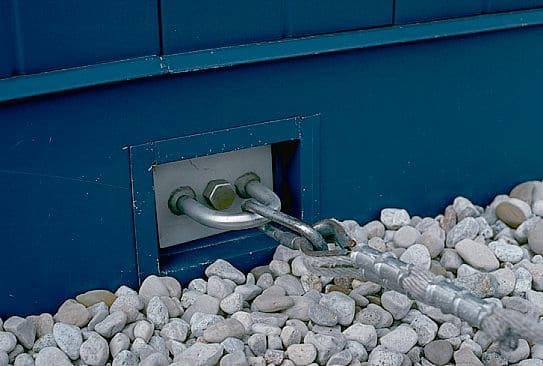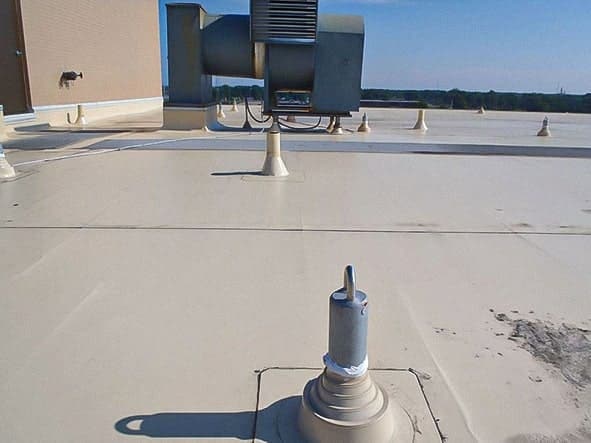Why Choosing the Right Roof Anchor Matters
Selecting the right roof anchor is crucial to ensuring safety and compliance in fall protection systems. Understanding the types of roof anchors and their capabilities for various roof types, including commercial, residential, and standing seam metal roofs, is crucial for ensuring adequate fall protection on the roof.
In the world of fall protection, there are various types of roof anchors, each with distinct applications, sizes, materials, and design considerations. There’s an array of anchors, some of which also go under many pseudonyms.
Some terms used for rooftop safety anchors may include
- permanent roof anchor
- tie-back anchor
- tie-off anchor
- wall anchor
- soffit anchor
- davit roof anchor
- safety anchor
- fall arrest anchor
- fall protection anchor
- anchor point
- horizontal lifeline anchor
- rooftop anchor
Read our in-depth guide to understand roof anchors for fall protection.
There are many others, but regardless of the term used, they can usually be put into one of a few major subcategories.
Roof Anchors by Type of Roof
Roofs can be divided into three general types: commercial, residential, and standing seam metal roofing. While they can be made of a mix of different materials (such as concrete and wood), the building application remains a crucial factor in determining the best type of safety anchor to install.
Commercial Roof
Commercial Roofing is generally a concrete-focused framework and can include brick and mortar, wood, steel, and reinforced wood, designed to support high-traffic areas and withstand heavy loads. Commercial roofing encompasses a wide range of structures, including retail buildings, apartment complexes, government buildings, skyscrapers, and other similar buildings.
One challenge on commercial roofs is that maintenance tasks are often quick, making workers more likely to skip fall protection steps. However, permanent roof anchors or horizontal lifelines can effectively solve this issue by providing ready-to-use, reliable safety points.
Permanent roof anchors, designed for steel, wood, or concrete, provide instant access to fall protection for workers without the need for setup time. Once installed, workers can secure themselves quickly and safely, which reduces the risk of fall incidents even on featureless, flat roofs.
These systems must be installed carefully to prevent water intrusion. Where roof penetration is not needed, non-penetrating anchor points or parapet clamps provide temporary, adaptable safety without affecting the structure. However, they typically require more setup than permanently mounted anchors.
Residential Roof
Residential Roofing is generally a wood-based framework and includes single occupancy homes, townhouses, spec homes, and some mixed-use venues. Unlike commercial applications, residential roof anchors are often lighter, cost-effective, and designed specifically for wood and tile structures. OSHA now requires residential contractors to invest in reliable, affordable anchor systems to ensure worker safety and adhere to the same fall protection standards as those for commercial roofs.
Standing Seam Metal Roof
Standing seam metal roofing is a steel- or metal-based framework that has a smooth, sloped surface, presents unique challenges for fall protection due to its lack of easy anchor points. This roof type is common in commercial and residential projects, where standard anchors often don’t suffice. Specialized clamp-style anchors are designed specifically for standing seam roofs, providing a secure attachment without requiring roof penetration.
Types of Roof Anchors
Although they may look the same, temporary and permanent roof anchors differ for various reasons and have their own sets of limitations, use cases, and follow separate compliance regulations. Selecting the right anchor is crucial to ensure the safety of workers and to make sure it offers adequate roof fall protection.
Permanent roof anchors
The major permanent roof anchors include U-bar anchors, Tie-Back Anchors, Soffit Anchors, Wall Anchors, and recessed or Concealed Anchors. The proper usage of each depends on several factors, including building design and environmental needs, with the roofing type being one of the most critical factors.
Traditional Permanent Roof Anchors are the backbone of the fall protection industry and represent the “bread and butter” of any good safety system design.
Permanent roof anchor points are almost always made from galvanized steel to prevent rust. Pro-Bel offers various mounting options, such as bolt-in-place, welding, and concrete casting, and is welded to the embedded plates to suit your building’s structure. These rooftop safety anchors are the most versatile and can be installed on commercial, residential, or even seam metal roofing.
Vertical Steel Pier Anchors: The most common type of anchor in the fall protection world is the vertical steel pier anchor. These types of anchors all differ based on the design of their base and are customized to the roof’s structure. They can be used for various tasks, including window washing, maintenance work, and fall protection. Horizontal Lifeline Systems can also be utilized with these types of anchors, with the safety cabling being strung through the anchor tie-off points, making them a very versatile choice for building safety systems.
U-Bar Anchors: As their name implies, this type of anchor utilizes a range of U-shaped designs, from a simple metal bar welded into a U shape to a full safety anchor with built-in reinforcing beams. The actual tie-off anchor point can also differ, depending on the design and complexity of the U-Bar anchor. Some models utilize a Swivel U-bar that can rotate to distribute the load, while others use fixed U-bars. Regardless of the U-Bar model, there will, however, be vertical attachment points that the worker ties off to. These are shorter and smaller than the vertical steel pier anchors and are typically used for rooftop fall protection systems, rather than window washing.
Soffit Anchors: They are generally installed on the underside of a structure, such as under a balcony, terrace, or other architectural overhang. They’re also often used in monorail systems and are most often installed for commercial roofing.
Wall Anchors: As the name suggests, wall anchors are usually installed into the side of a wall and are typically used for fall protection systems. They can be installed flush against a wall or often on the inner lip of a parapet, usually come in the U-Bar style design and are most often installed for commercial roofing projects.
Concealed Anchors: These anchors, also known as Recessed Anchors, are placed below the roof surface with a covering plate overtop that completely conceals them when not in use. They are an excellent idea for anchors in publicly accessible places, such as penthouse balconies, and offer much-needed safety without compromising the building’s aesthetic value, making them an attractive option for both commercial and residential roofing.
Temporary roof anchors
Temporary roof anchors are designed for short-term tasks, providing a flexible and portable solution for safe roof access on various surfaces. They are intended for one-time, quick-use jobs and can range from cabling with a support ring wrapped around an existing I-beam to larger plugs that affix directly into concrete. They are not intended for long-term engagement and should be replaced with permanent roof anchors as soon as possible.
Multipoint anchors
Multipoint Anchors combine two or more of the previous anchor types to offer greater design flexibility and safety.
Multipoint anchors integrate two or more anchor points to enhance safety and adaptability for complex roof structures. This setup offers greater design flexibility, enabling safe access to multiple areas across a roof while maintaining secure tie-off points for workers performing various tasks. Ideal for large or irregularly shaped roofs, multipoint anchor systems support both horizontal and vertical movement, making them a reliable choice for comprehensive fall protection on a wide range of projects.
Horizontal Lifeline Anchor
Horizontal lifeline anchors are primarily used for fall restraint, offering continuous safety along a fixed path. A cable system runs horizontally across the roof, allowing workers to clip in with a lanyard and move securely along the line. This setup can be integrated with existing permanent roof anchors to hold the lifeline in place and maintain safety across extended or high-traffic roof areas. Ideal for applications that require frequent access to multiple roof zones, horizontal lifeline anchor systems ensure a balance of mobility and protection.
Take the next step toward safer rooftop access. See our permanent roof anchor solutions and download a brochure today.
Share this Post




